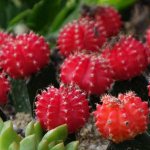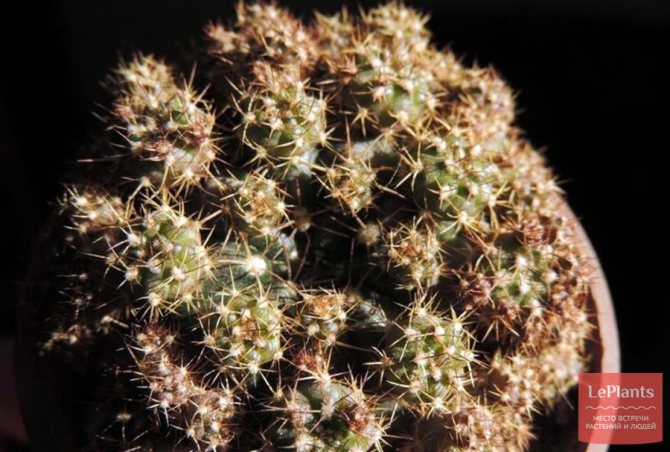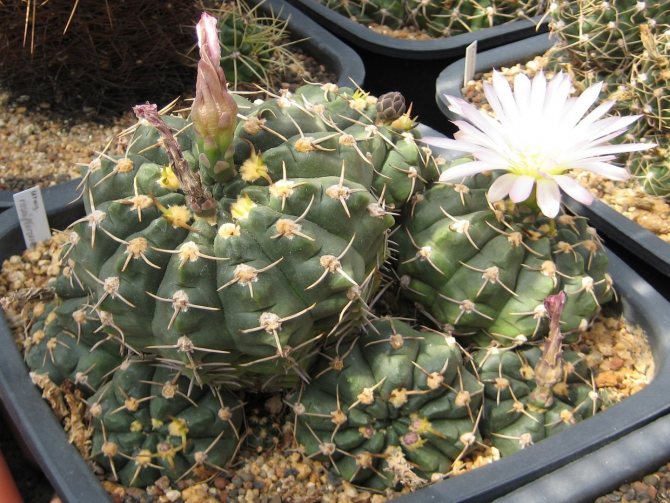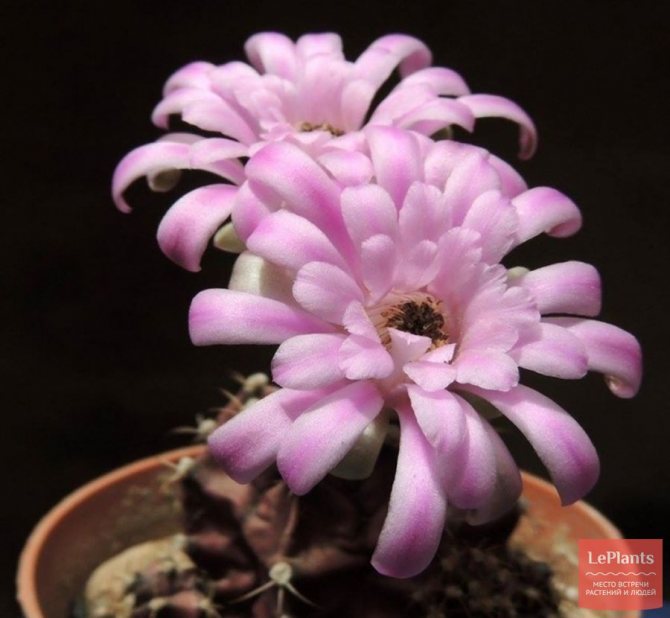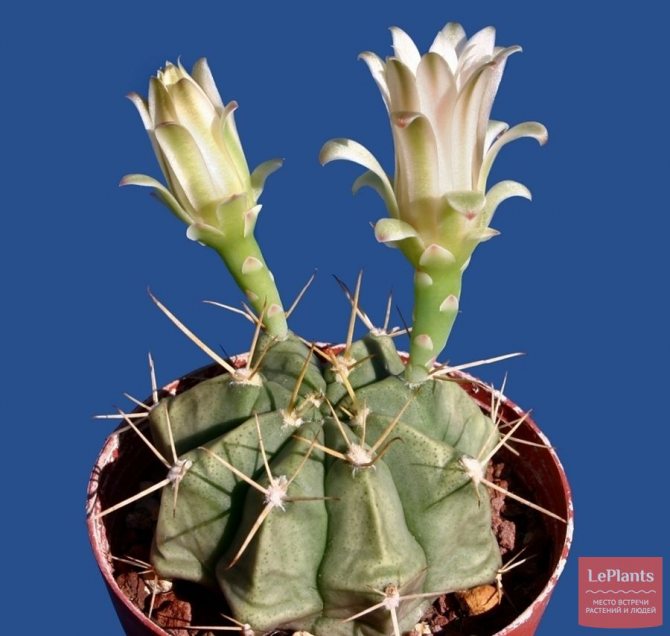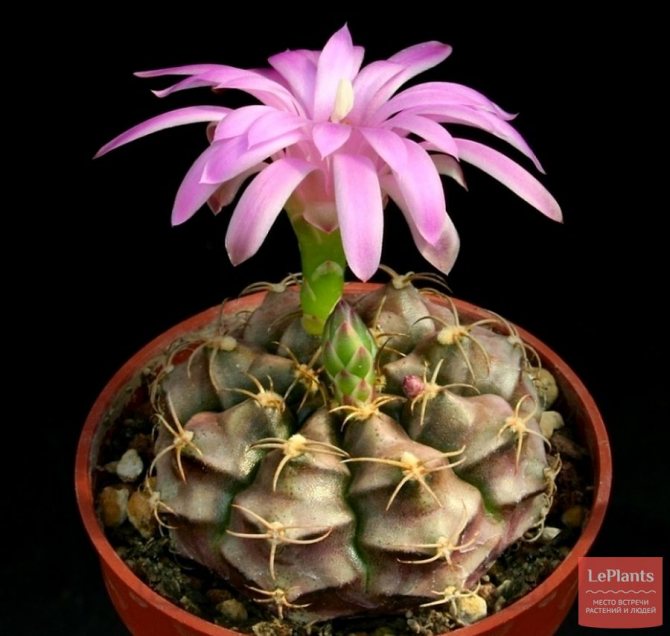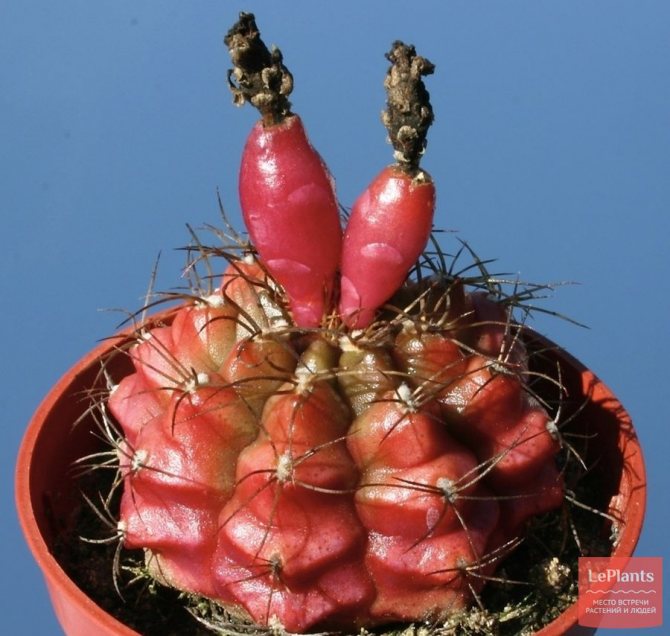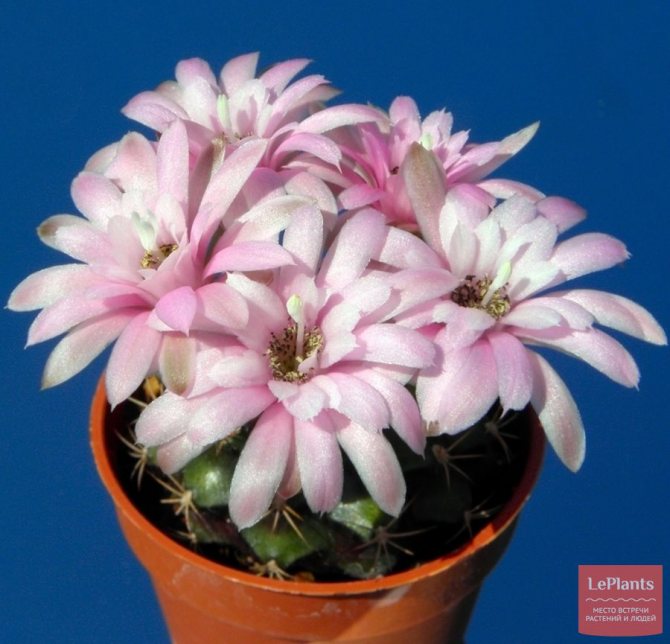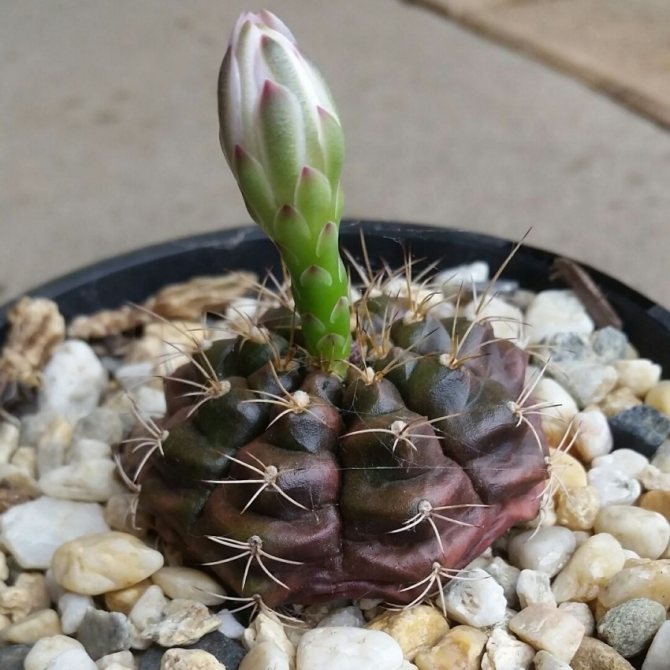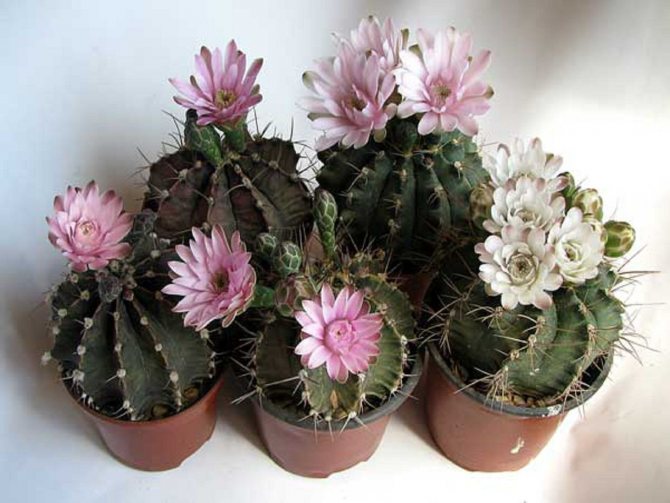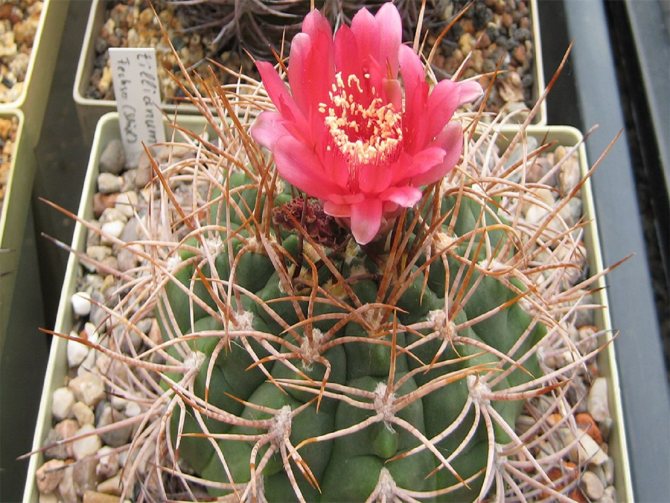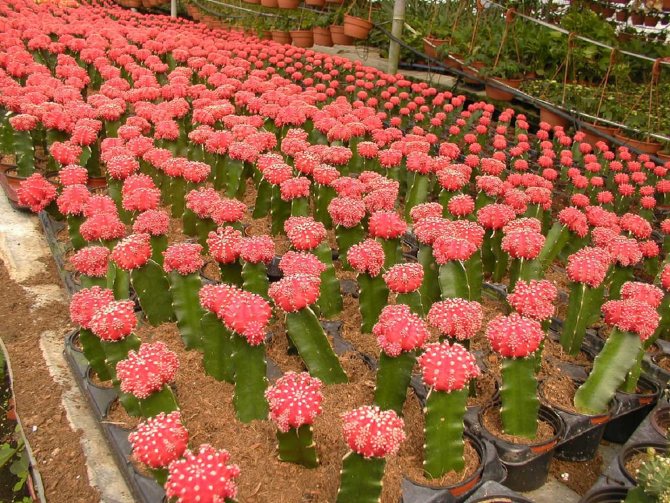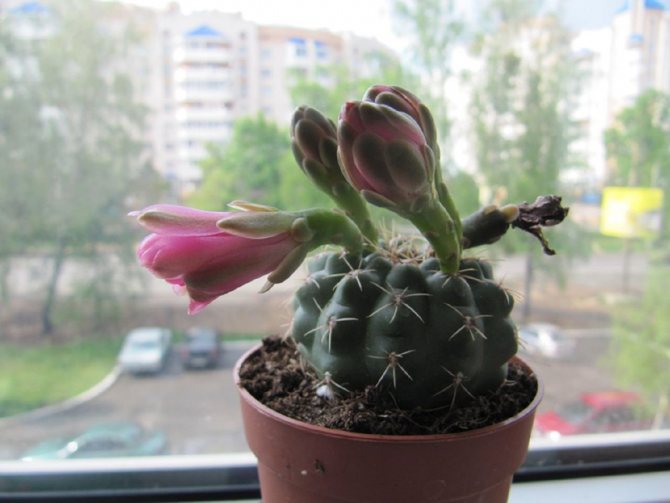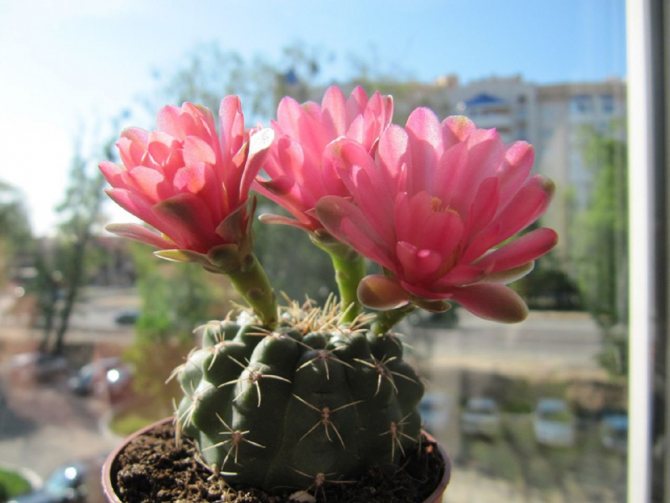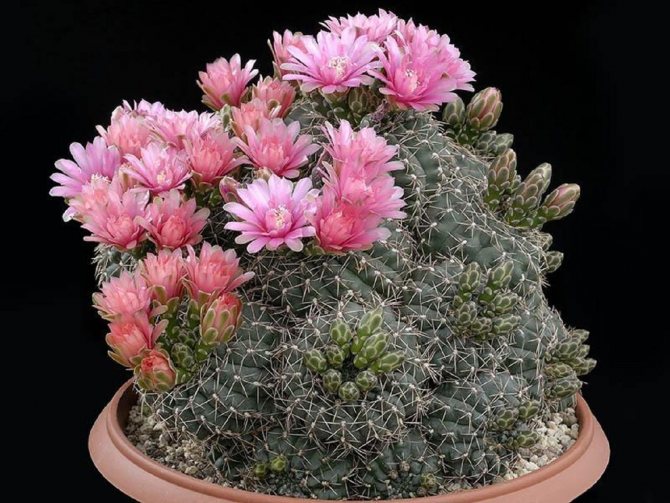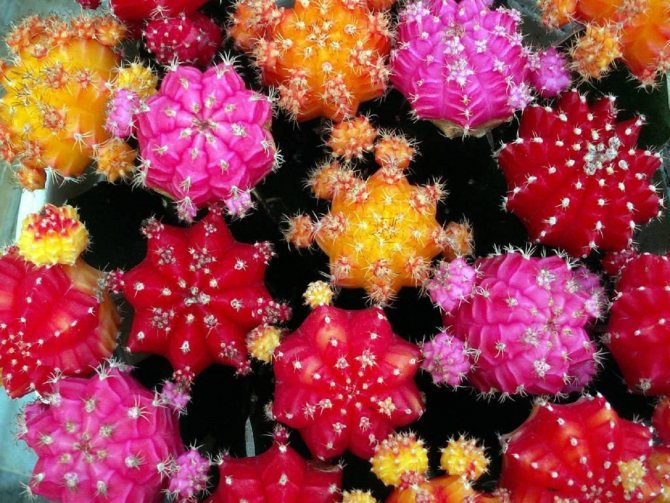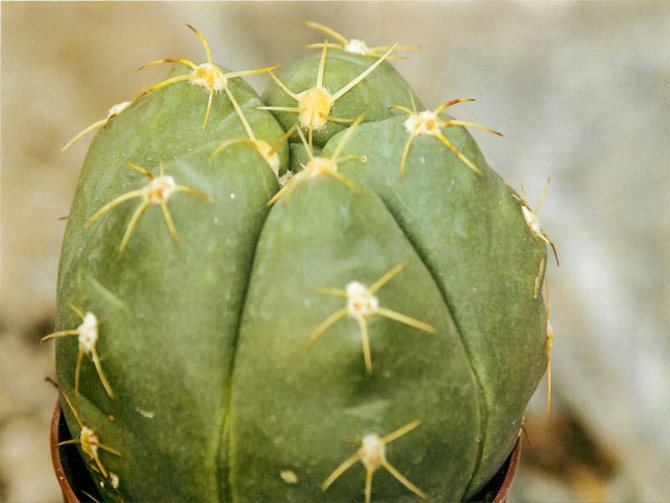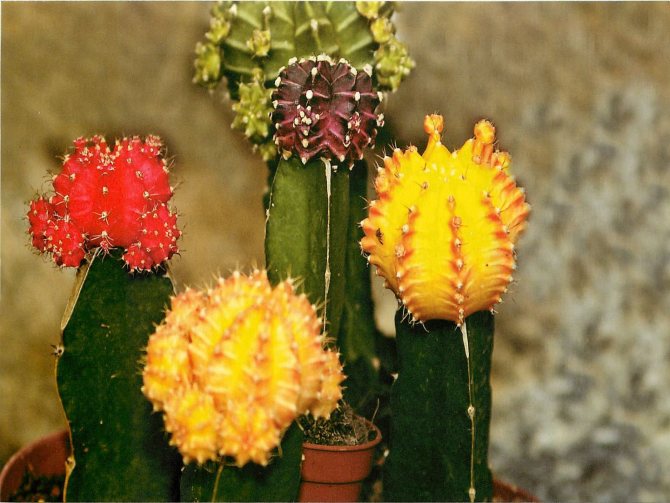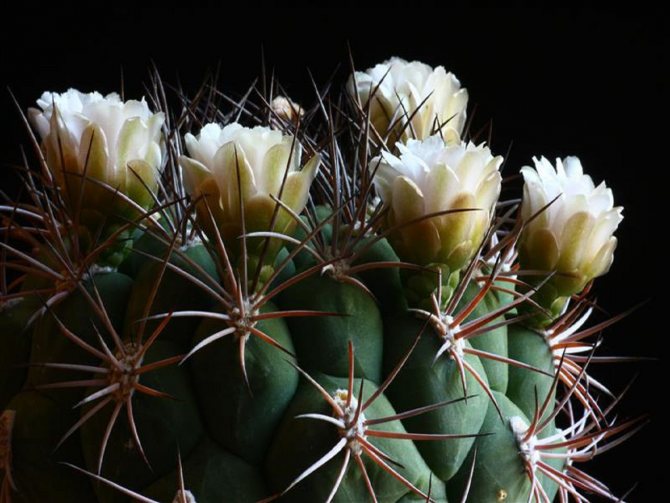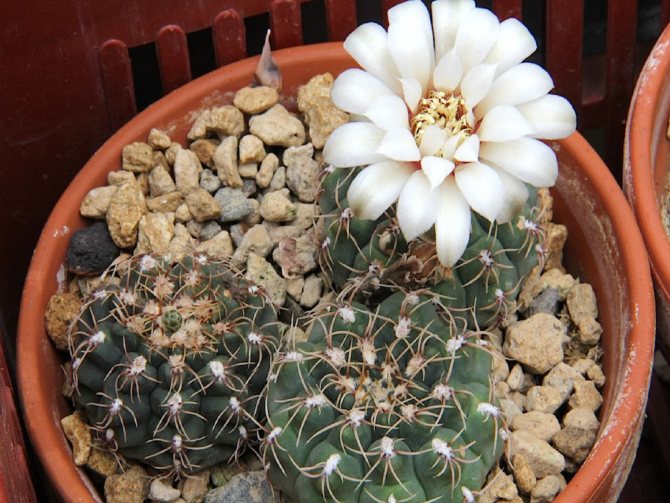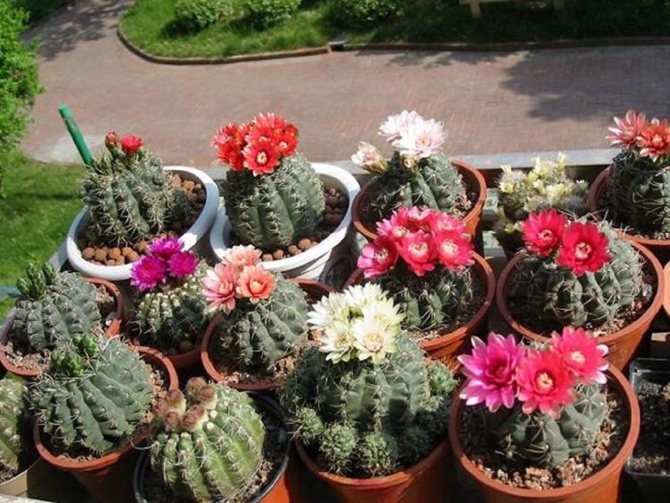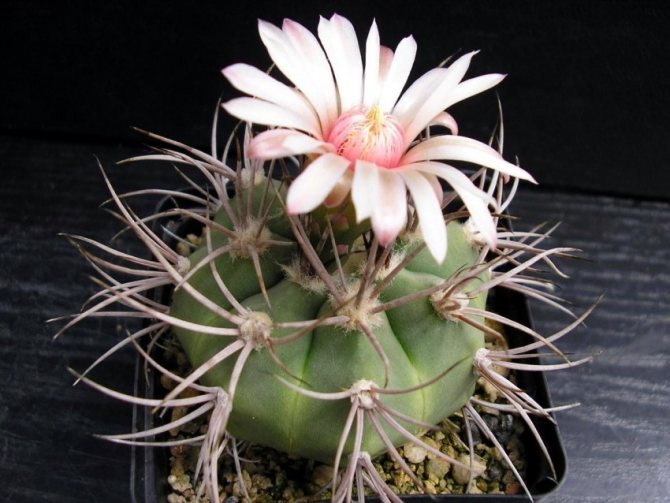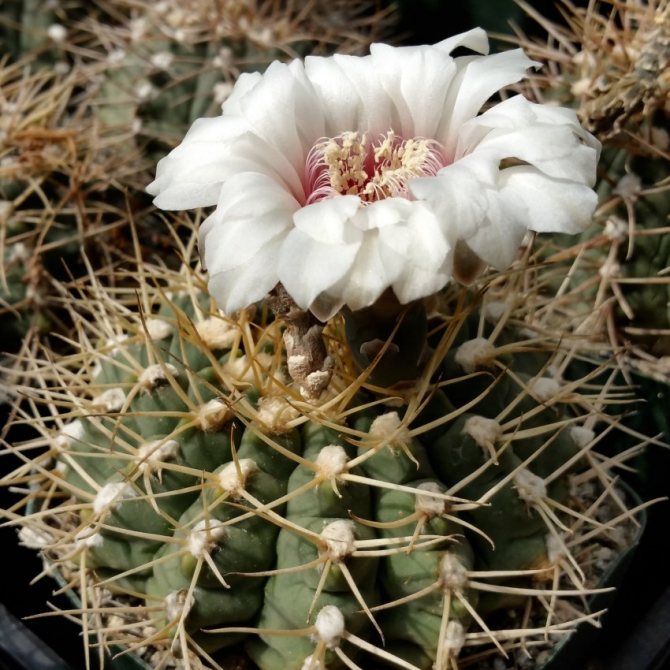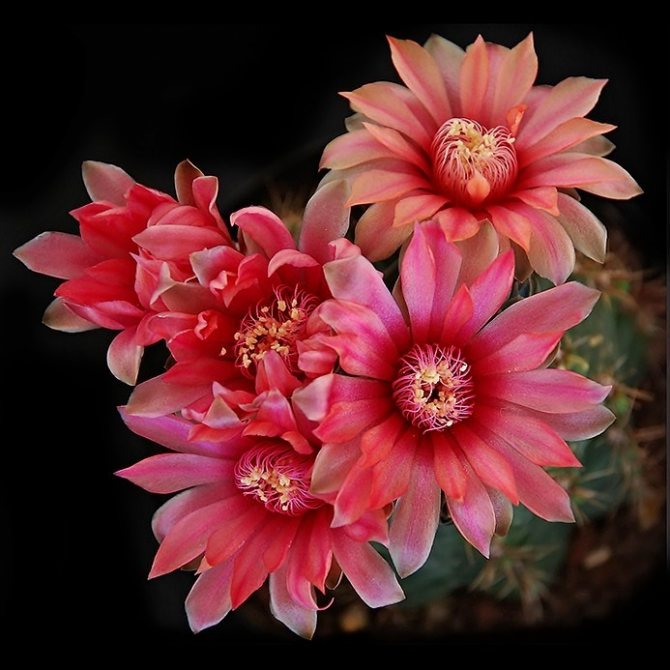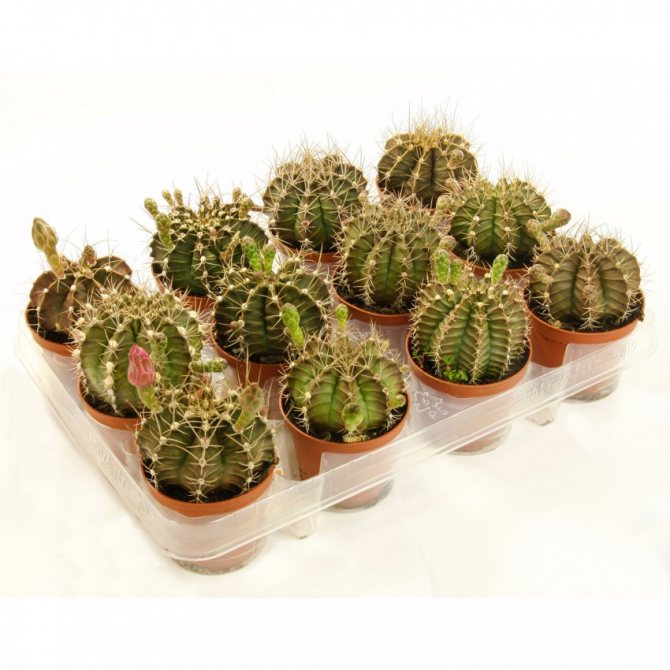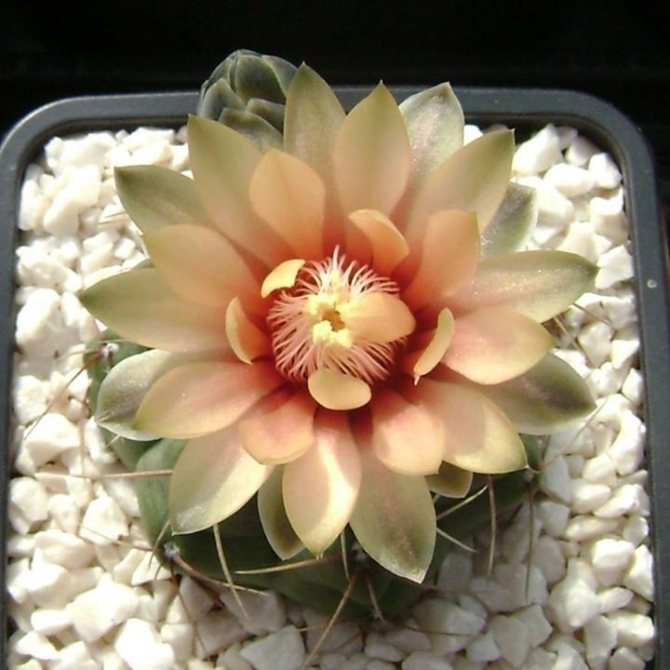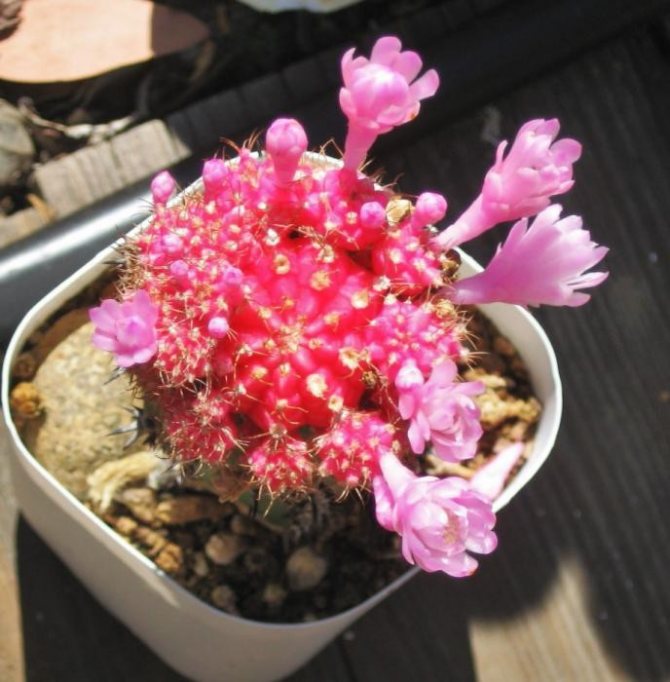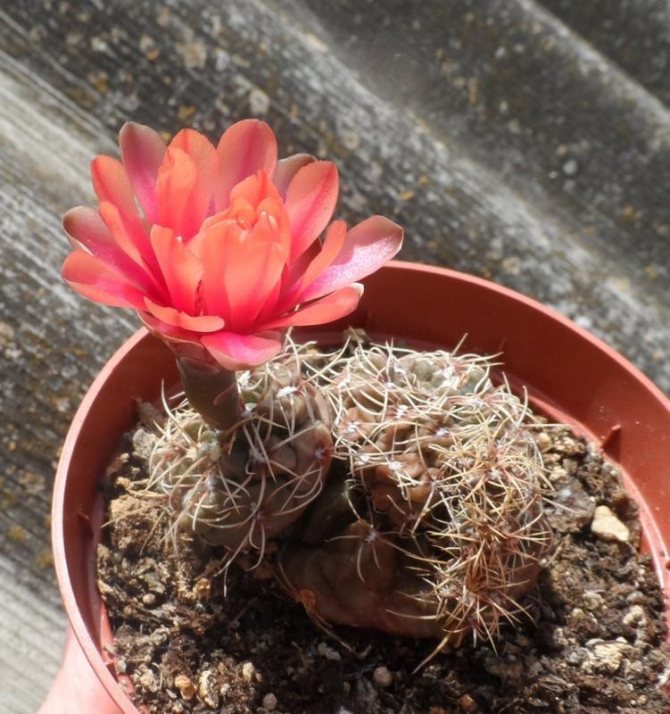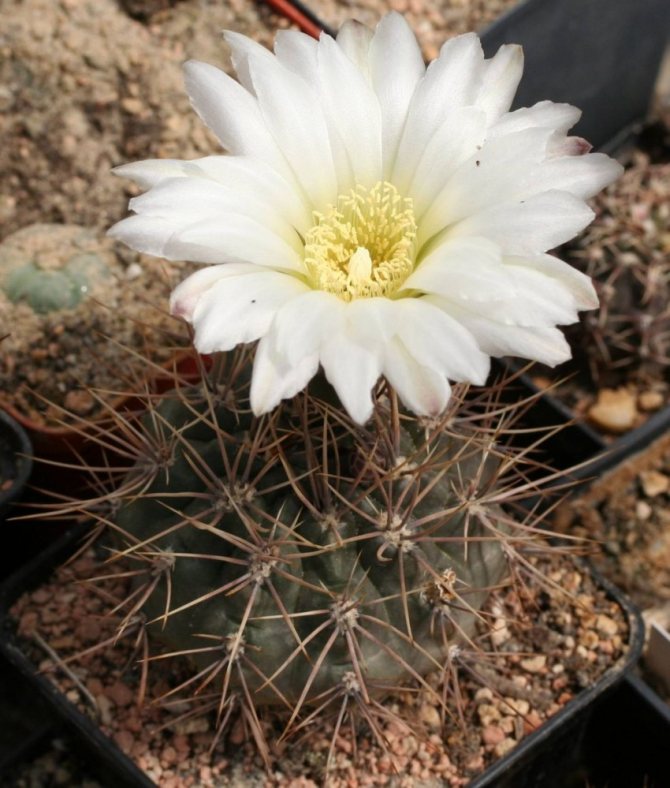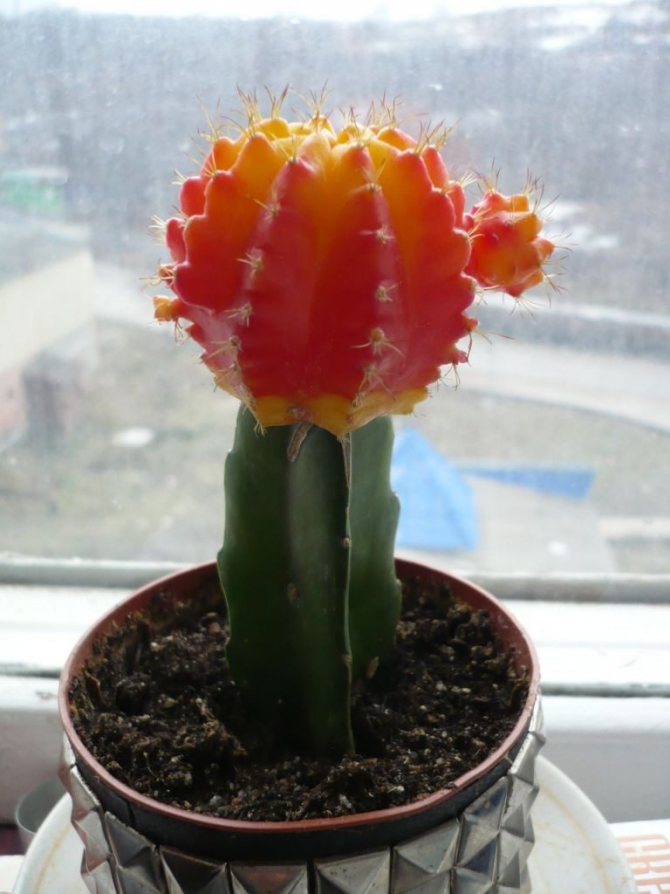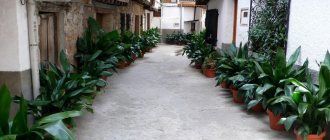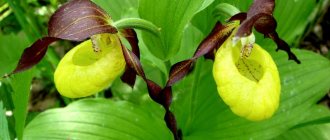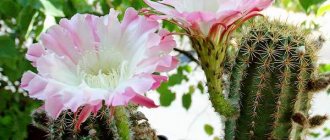Gymnocalycium is a medium-sized succulent with an unusual stem and beautiful apical flowers.
The Latin name indicates an interesting feature of the flower tube - it is surrounded from below by smooth scales, devoid of thorns (gymnos - translated means "naked").
In the wild, representatives of the genus are found in most countries of South America. The form of plants is so diverse that it is sometimes difficult to believe in their relationship. In indoor floriculture, species are widespread with a medium-sized single spherical or cylindrical stem of green, pale green, brownish green, 10 cm high and 4-15 cm in diameter.
The stem of some plants consists of longitudinal straight and high ribs, while others are formed by protruding tubercles. On their tops are woolly areoles dotted with radial needles 5-12 mm long (or more). They are straight or slightly curved, sticking out in different directions.
Most hymnocalycium blooms profusely in April-September, with the corolla fully opening. An elongated flower tube without hairs or spines is covered with large scale-like leaves. The length of the ovoid fruit is 1.2-3.8 cm.
General information
Large flowers are located on a long, smooth tube with small scales tightly attached to it. Thanks to her, the plant got its name: gymnos ("gymvos") means naked, and calicium ("calycium") - a tube. At night, the buds are closed, and in the morning the flower blooms again.
Gymnocalycium begins to bloom for 2-3 years in summer and spring. The color can be chosen for every taste - from cream to bright red or raspberry. After flowering, a fruit with seeds is formed. Gymnocalycium is a perennial plant with a slow growth rate.
What else is it called?
The plant was originally named Echinocactus denudatus, however, in 1845 the name was changed to Gymnocalycium denudatum. Also, this succulent is called Cereus denudatus.
In addition, this species has 3 subspecies, namely: Gymnocalycium denudatum var. roseiflorum, Gymnocalycium denudatum var. bruennowii and Gymnocalycium denudatum var. paraguayense. These varieties are considered synonymous names to the main branch (read more about other types of hymnocalycium here). In general, this cactus is called "Spider".
Variety of species: names and characteristics
- Gymnokalycium Mikhanovich
It has a flattened stem that is either grayish-green or brownish-reddish in color. Gymnokalycium Mikhanovich blooms in red, white, pink, yellow or orange flowers.
- Gymnocalycium of Friedrich
This cactus is brownish red-brown or lilac-burgundy. It contains the least chlorophyll. In common people it is called "little red riding hood" for its appearance.

- Gymnocalycium Japanese
This is the form of Friedrich's Gymnocalycium. Due to the complete absence of chlorophyll, the plant has a bright color of the stem. The most common are deep yellow or red. This species is grafted onto any green variety, because it cannot take root in the ground. It turns out a very beautiful mix of bright saturated colors.
- Horst Gymnocalycium
Dark green cactus with a flattened, spherical stem covered with small yellow spines. The cactus has 4-6 rounded edges. In late spring, the hippokalycium blooms with lilac-pink flowers with pink stripes in the center of the petal.
- Gymnocalycium Andre
It is grown in groups. The cactus does not like abundant watering and excess light. Its flowers form bushes of many bright yellow heads.
- Gymnocalycium baldianum (or balda)
Begins to bloom earlier than other varieties. In early summer, purple flowers will appear. And the stem of the baldiamum hymnocalycium is gray-green with a blue tint.
- Gymnocalycium nude (naked)
Shiny green stem with few spines. Approximately 8 cm high.
- Gymnocalycium humpbacked (or lumpy)
Spherical matte green stem. Height 20 cm. Diameter 10 cm. Flowers white, cream or pinkish. Long yellow-brown spines.
- Gymnocalycium tiny
Smallest species. No more than 3 cm in diameter. A very small cactus with white flowers 6 cm long.
Botanical description
Indoor plant Gymnocalycium nude or Gymnocalycium denudatum in Latin is a representative of the genus Gymnocalycium. Friedrich Zellow discovered in 1825, having discovered it in Uruguay.
The stems of the plant are round, 9-11 cm in diameter. In the lower near-root part, lateral shoots are formed. The surface of Denudatum is smooth, shiny, green in color. The whole cactus is divided into 5-6 lobes or ribs, delimited by vertical shallow grooves.
The cactus has only radial spines, located in groups of 4-5 pieces, and in the root zone of 7-8 pieces. In length, these spines grow up to 1 cm, pale yellow, curved shape, adjoining the stem.
During the flowering period, an elongated flowering tube rises from the center of the cactus, and the flower itself reaches 4-6 centimeters in height. The flower is beige-yellow, wide, with bent petals.
Home care
It is easy to care for the Gymnocalycium. The cactus is very resistant. Perfect for beginner florists. Gymnocalycium is unpretentious. To care for him at home, it is enough to follow the following recommendations.
Gymnocalycium loves light, so it is better to put it in a well-lit place. For flowering, it is very important not to leave it in the shade, especially in winter. However, in summer, direct sunlight should be avoided so that the plant does not get burned. To do this, at the peak of the heat - from 12 to 4 - it is better to slightly darken the lighting with a curtain made of tulle or a sunscreen. Bright, but diffused lighting is ideal for the gymnocalycium.
NOTE
Autumn and winter are a time of rest for the gymnocalycium. If there is little light, it is recommended to provide additional artificial lighting.
Gymnocalycium does not tolerate excess moisture. Water it as it dries up with warm water for a day or two. In summer, watering will be plentiful, and closer to autumn it will decrease. It is not recommended to spray with water. From this, white traces appear on the plant.
NOTE
In cold weather, reduce watering to two to three times per season.
For planting, you can buy ready-made cactus soil from a gardening store. Or make a suitable mixture yourself. To do this, mix in equal amounts of humus, peat, turf and add a little brick chips and charcoal.
Feed hymnocalycium in spring and summer with a frequency of 1-2 weeks with special fertilizers for cactus plants. In winter, the cactus falls into a dormant state, so it is better to interrupt feeding.
The plant should be transplanted in the spring. The pot is slightly larger than the old one. The cactus is quite comfortable to bloom in cramped conditions. A young hymnocalycium is transplanted annually, and an adult every four years.
Gymnocalycium should be grown in a moderate temperature (15-18 degrees). Even in winter, despite the fact that the cactus can withstand up to -5 degrees.
Humidity can be any. The cactus thrives in both dry and humid climates.
It is not necessary to specially moisten it by spraying.
Similar plants
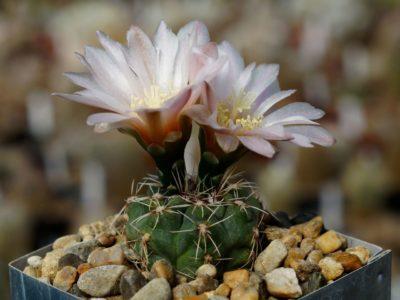

Representatives of the Gymnocalycium clan are similar to each other.
- For example, Bald's Gymnocalycium is quite similar to nude. Only the first has more pronounced processes, spines and a red flower.
- Erinaceum differs from Denudatum only in the presence of thorns and a bumpy surface.
- Anisitsi has on the segments something similar to mountain ranges, on which there are processes and thorns, and the flower has a pleasant pink color.
- The type "bright red hymnocalycium" is similar to the Nude one, however, the processes of the first braid the surface of the cactus and the flower of light or dark red color.
- Andre's view is inferior in size to Denudatum, but has a similar structure and flower.
Gymnocalycium Denudatum is a beautiful, compact and exotic plant. It will definitely appeal to collectors and amateurs. Possessing it will become a pleasant feature of your interior, emphasizing love for nature and high aesthetic taste. By adhering to the rules outlined in this article, you can grow a worthy specimen of a beautiful plant.
There are a huge number of varieties of Gymnocalycium. Read about the secrets of growing Japanese, as well as Saglionis and mix varieties on our Internet portal.
Reproduction
There are two ways to reproduce hymnocalycium: seeds and lateral layers.
The first method makes it possible to get better quality and healthier offspring. The seeds are planted in a small pot with a dampened mixture. Before planting, the soil must be calcined in the oven for disinfection. At first, it is better to cover the seeds with a foil or a lid so that the soil is constantly moist. In this case, do not forget to spray or water through the pallet. For seed germination, a temperature of 18-20 degrees is suitable. Within a year, the seedlings can be planted in separate pots. You can plant seeds at any time of the year. The main thing is to comply with all conditions.
The second way is easier. It is necessary to separate the lateral cut from the main stem, dry the cut site for several days. To do this, place the scion on a newspaper. Let it sit for a few days. Then we plant it in moist soil. It will take root very quickly, and you need to care for it like an adult cactus. If the children have roots, then you need to carefully dig it up and transplant it into a separate pot.
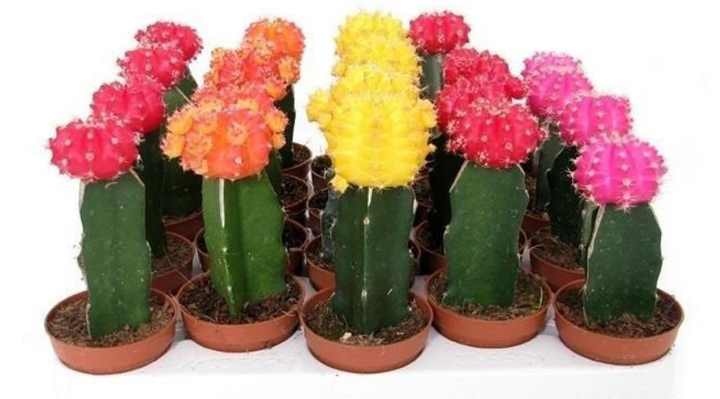

Gymnocalycium transplant rules
You need to transplant the cactus as it grows. Young specimens grow faster and need more frequent transplants. In addition, a transplant is needed if the plant's roots begin to rot.
In specialized stores, you can purchase special soil for succulents. You can cook it yourself. For this you will need:
- Leaf humus - 2 parts.
- Peat - ½ part.
- Sod land - 1 part.
- Sand or perlite - ½ part.
- Charcoal - 2-3 tablespoons.
You need to transplant the plant in the warm season. If the cactus is blooming at this time or has begun to release buds, it is better to postpone the transplant until the end of flowering.
A new pot needs to be chosen in several large sizes. There must be drain holes at the bottom. Expanded clay is poured at the bottom to ensure the drain of excess moisture.
When transplanting, the plant is carefully removed from the old soil. It is important not to damage the roots. A dry earthen lump is removed by hand and using a wooden skewer or toothpick. The new soil for the cactus should also be dry, you can water it no earlier than after 1-2 weeks. The plant is buried in the ground no higher than the level of the root collar.
If damaged areas of the root system are found during transplantation, they should be removed. The wounds are sprinkled with wood ash or crushed activated carbon. After that, the roots are left to dry for several hours.
Graft
Vaccination is needed for chlorophyll-free cacti. Such hymnocalycium is red. It is difficult for them to grow separately, so the best option for them is crossing with a green cactus. The result is a very beautiful variety with green and red stems at the same time.
Gymnocalycium is planted in the same way as other cacti. Cuts are made on both plants. Attach by connecting the conductive bundles.And, having chosen the desired position, they fix it with a bandage. The main thing is not to fix it very tightly. The bandage is not removed for a week.
Do I need to fertilize
If desired, the soil can be fed, not forgetting that:
- We fertilize only in the spring-summer season.
- No more than once every two weeks.
- We use special mixtures and formulations selected for cactus species.
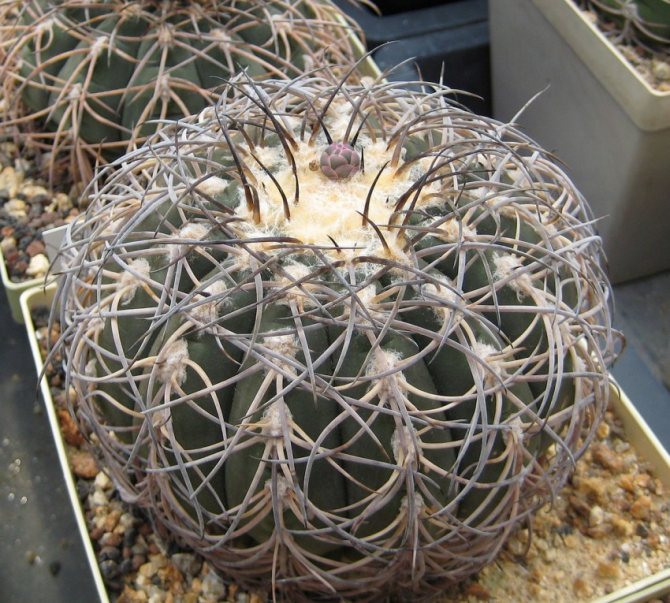

However, there is no special requirement for a cactus in top dressing: this plant, like all tropical varieties, is able to exist in completely Spartan conditions.


Diseases and pests
Red flat tick causes the greatest harm to cacti. Gymnocalycium has a very thick skin, so the pest rarely settles on it. Young shoots with a thin, fragile skin are mostly at risk. The appearance of a tick can be determined by dry, rust-colored spots. To get rid of it, smear the stems with ethyl solution or rinse them under running hot water. You can, of course, buy a universal pesticide, but it is better to do this in extreme cases, when not one, but a whole family of cacti is under threat.
On the roots or stems of the hymnocalycium can settle mealybug... It is a small pinkish worm that sucks sap from plants. It can be seen with the naked eye. If the pest settles in the roots of the plant, then the flowers stop appearing, and the hymnocalycium no longer grows. To get rid of the worm, rinse the roots for a long time with hot water or buy special medicines in the store.
In addition to pests, hymnocalycium is prone to rot. They occur if the plant is watered too vigorously or kept at the wrong temperature. Roots are most often affected. To save the cactus, you need to rinse the affected areas with hot water. Cut off all the rot, and disinfect the healthy part with crushed coal or fungicidal preparations. Then dry the roots for several days and plant in a new pot.
Differences between Denudatum and other species


Unlike Gymnocalycium denudatum var. paraguayense original view does not have a lot of bumps on the surface, it is smooth in Denudatum. Also, the flower of the latter plant is pale yellow or cream, while the paraguayense is exceptionally white.
Gymnocalycium denudatum var. bruennowii has a more teardrop-shaped shoot than the classic Gymnocalycium.
Gymnocalycium denudatum var. roseiflorum can be distinguished from Gymnocalycium denudatum by its flower, since the first cactus has a wide flower with long petals and pink color.
Growing problems
Problems when growing hymnocalycium in indoor conditions arise from improper care of the plant. Most often, flower growers are faced with the following troubles:
| Problem | Causes of occurrence | Ways to rectify the situation |
| Slower growth |
| Transplant the cactus into a slightly alkaline soil and water it only with filtered water at room temperature |
| Lack of flowering | Unsuitable conditions of detention in winter | In order for the hymnocalycium to bloom next year, it is necessary to move it to a cool and dry room in winter. |
| Shedding buds |
| Protect the cactus from drafts and provide it with additional lighting. |
| The appearance of spots at the base of the trunk | Excessive watering | Water the cactus only when the topsoil dries out |
If the base of the cactus has darkened, but remains dry and hard to the touch, then this phenomenon indicates the beginning of the corking process. In this case, no special measures should be taken.
Gymnocalycium saglione
Accepted Scientific Name: Gymnocalycium saglionis
(F.Cels) Britton & RoseCactaceae (Britton & Rose) 3:157.1922 Britton & Rose
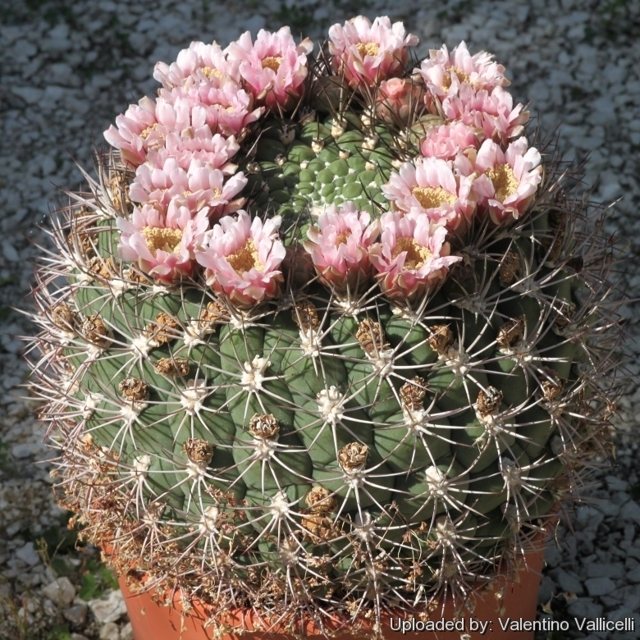

Gymnocalycium saglione
(
Gymnocalycium saglionis
)
Photo by: Valentino Vallicelli
Origin and Habitat:
Gymnocalycium saglionis
has a wide range and is locally abundant in Argentina (Jujuy, Catamarca, La Rioja, Salta, San Juan, Tucumán). It was Originally found in Dept. Trancas, ca. 12 km al norte de Tapia en la ruta 9 a Vipos, 700 m, Tucumán.
Altitude range:
240 to 2,600 meters above sea level.
Habitat and Ecology:
This cactus grows on rocky hills within monte and chaco habitats together with
Echinopsis leucantha
, and
Trichocereus terscheckii
... This species is common and abundant.
It is present in several protected areas and there are no majorare no threats affecting it.
- Synonyms:
- Common Names include:ENGLISH:
Giant chin cactus
Description:
Gymnocalycium saglionis
is a solitary barrel cactus, rather flattened, often very large, with long spreading and sometimes recurved spines. They are a rich brown and form a pleasing contrast against the gray green body.
Stem:
Flattened globose to shortly cylindrical more or less flattened up to 30 (40) cm in diameter, 15-30 cm tall occasionally up to 90 cm tall, dull-green or blue-green. Apex spineless.
Ribs:
10-32 according to the size of the plant, low, very broad, sometimes 4 cm. long, separated by wavy intervals, divided into large, low, rounded tubercles.
Landing
To plant a cactus, you need to purchase a small pot made of plastic or ceramic. It must have drainage holes. Large containers for hymnocalycium are not suitable, since the plant needs to feel the walls of the pot with the root system.
You can prepare the soil yourself by combining the following components:
- 3 parts each of leafy earth and sand;
- 2 parts of sod soil and peat;
- 1 part crushed charcoal.
The soil for the hymnocalycium should be neutral or slightly alkaline, since the cactus does not tolerate acidic soil.
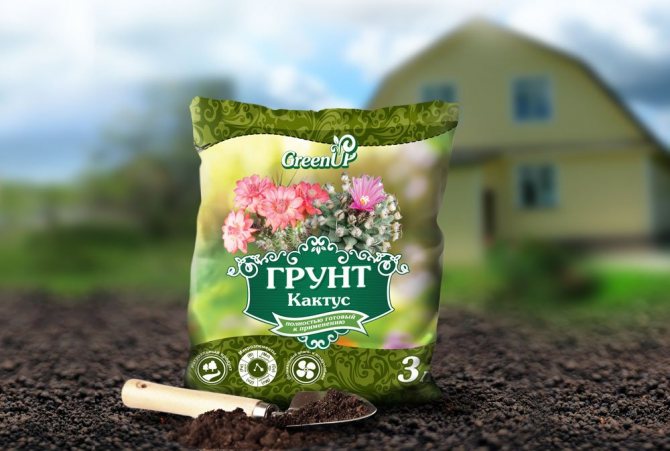

Ready-made cactus soil can be purchased at a flower shop. Before planting, it is necessary to put a layer of drainage on the bottom of the pot and only then fill the soil.
Moistening the soil
It is not difficult to water the hymnocalycium correctly - the principles are suitable for almost all plants living at home. It is watered as the soil dries out in the pot. Watering is carried out preferably with settled water, heated at room temperature.


In the summer, the plant is watered moderately, but regularly, and from autumn to spring it is watered occasionally and little by little. It is important to take care of drainage, pour excess liquid out of the pan, and allow the earthy coma to dry completely between waterings.
Beneficial features
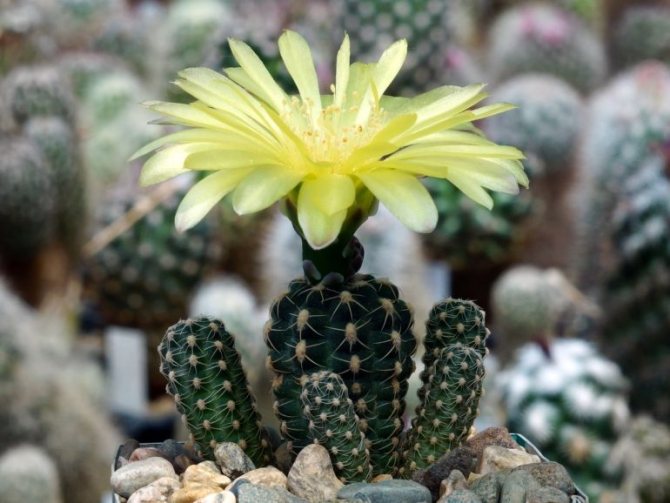

Gymnocalycium. Photo
Traditionally, they try to put this cactus closer to computers, because they believe in its ability to absorb harmful radiation. This cactus has a beneficial effect on the indoor atmosphere, purifying the air and filling it with useful substances.
Sometimes cacti are even eaten, and various objects are made from it, for example, soap and deodorants.
Dormant period
The dormant period for this cactus begins in the fall.
The dormant period in the hymnocalycium is clearly pronounced, begins in late autumn and lasts all winter. During this time, the plant can be placed in a cold room (9-14 ° C), where there is little light. Top dressing is stopped, and watered very rarely, only so that the earthen lump does not dry out at all. An insulated loggia is suitable for content. In severe frosts, it is better to bring the cactus into the apartment. After waking up, the plant is washed from dust and gradually accustomed to sunlight.
Gymnocalycium saglionis - Gymnocalycium saglionis / Code r-1877
Gymnocalycium saglionis - Gymnocalycium saglionis is a spherical cactus native to South America. The name is from lat. gymnos - naked and calycium - calyx, associated with the flowering of this beautiful member of the cactus family. The fact is that the flower-bearing tubes of hymnocalycium, formed from the areoles at the top of the stem, differ from other cacti, they are naked (without hairs and bristles), covered with smooth scales. Location: Gymnocalycium needs plenty of bright light. For greenhouse cultivation in extreme heat, shading is required. Temperature: Spring - autumn - moderate. Gymnocalycium needs fresh air, open windows on warm and hot days. In winter, the content at t is 15-18 C, it is possible at lower temperatures, up to 5 C. Watering: In winter, it is reduced to a minimum. From spring - a gradual increase in watering. In summer, if necessary, with warm water. Air humidity is low, no spraying is required. At the beginning of autumn, watering is reduced, and by the middle of autumn, it is sharply limited - rarely and little by little. Transfer: At a young age - annual (in spring), then - as needed. The transfer capacity should always be slightly larger than the old one. Soil: slightly acidic reaction, sod or leafy, peat, coarse sand with charcoal and brick chips (3: 2: 2: 3). Vegetative propagation: Gymnocalycium, some of their species, release lateral layers, with which cacti are easy to propagate. There are species that intensively form lateral processes, they need to be thinned out to form decorativeness, some, on the contrary, are a limited number and are especially beautiful in multi-headed groups.The shoot, separated from the stem, leave in a dry place for two days, then place it on a moist substrate (ordinary cactus soil), where the shoot quickly releases roots by clinging to the soil. Reproduction by layering is carried out during the growth period of cacti - in spring and early summer. Seed propagation: Most hymnocalycium reproduce only by seed. It's simple, besides, cacti grown from seeds are of higher quality and healthier than those grown from lateral processes. Sowing soil - the same as for adult plants or more fine-grained, it is imperative to heat it up in the oven or in a microwave oven for half an hour. Take regular shallow plastic containers, fill with substrate and moisten it, spread the seeds over the surface. It is necessary that the substrate is always moist, for this cover the seed container with a transparent lid or plastic. Germinate the seeds at a temperature of about 20 C. Moisten the drying substrate from the pallet or by spraying.
It is possible to sow hymnocalycium, with sufficient light and heat supply, all year round. They grow well and can be transplanted into separate containers already at the age of one.
You can buy Gymnocalycium saglionis - Gymnocalycium saglionis for only 45.00 rubles. The store features Gymnocalycium with descriptions, as well as detailed specifications and photos. We offer all products with a guarantee and delivery within Russia.
Main pages
Content
- Description
- Gymnocalycium care Cultivation
- Watering
- Fertilizing Gymnocalycium
- Gymnocalycium transplant
- Bloom
- Diseases and their treatment
- Gymnocalycium naked

